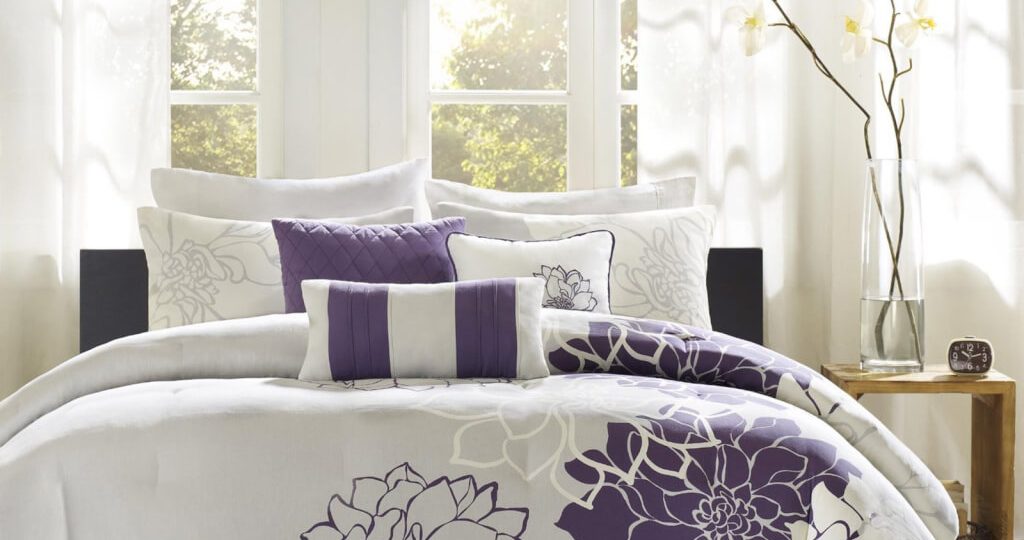Every purchase made online is encrypted with a high level of security you’ve come to expect. Your private information is never shared nor sold, so you can buy with confidence. You can also visit our store if you are in the St. Louis area.

You’ve finally gone through the process of choosing a mattress that works for you, finding a bed frame style that you enjoy, and picking out a matching headboard, but there’s one last crucial step in setting up the perfect bed: picking bedding. As many different types of mattresses as there seem to be, there are even more choices when it comes to bedding. Today, let’s talk about how to choose bedding that looks great and feels great.
In addition to the wide variety of choices available for bedding, you also have to take into consideration that not all bedding is suitable for every season, and you may need heavier or lighter bedding available to swap in when the weather changes. As if that weren’t enough, you still need to pick out bedding that matches the design of your frame and of your bedroom as a whole. All of these factors combined can make the prospect of choosing bedding an intimidating one, but I’m going to walk you through a series of steps that will guide you along the way.
The easiest way to start choosing your bedding is to simply go to a store and look around. If you are able to find one or two items that you really like it will be easier to build the rest of the bedding around that theme and design. Sometimes, it’s easiest to start by choosing which sheets you will place on the bed.
Table of Contents
Choosing Sheets
Sheets are an often-overlooked component of what makes up a comfortable bed. They are actually very important to the overall feel of the bed, as they are the piece of bedding that we have the most direct skin-to-fabric contact with. There are several factors to consider when deciding on a set of sheets:
Thread Count
The thread count of a set of sheets is usually the first thing that people look at when determining the quality of the fabric. The thread count is the number of vertical and horizontal threads in each square inch. Generally speaking, sheets with a higher thread count will feel smoother and softer than sheets with a lower thread count. Try to aim for a set of sheets with a thread count between 300 and 500. Anything above this range is often hard to distinguish, and may not be worth the extra money. While thread count is important, the type of fabric plays a huge role in how the sheets feel.
Fabric Type
The most common fabrics found in sheets today are cotton, polyester, and blends between the two. The choice of fabric comes down to personal preference in regards to temperature and texture, but there are a few things to keep an eye out for when picking a piece of fabric. Cotton tends to be soft and warm, while polyester is rougher. Polyester sheets can oftentimes last a lot longer than cotton sheets, and oftentimes a blend is preferable to either of the materials on their own.
Choosing A Blanket And Comforter
Some people choose to use only a blanket or comforter, but it’s common for beds to have both. The primary difference is that a blanket is made of woven fabric, while a comforter is generally stuffed with fibers to add weight and warmth. Blankets come in a wide variety of fabrics, while comforters are usually made from either cotton or polyester.
If you decide to use both a blanket and comforter, it’s a good idea to get a blanket made from a thinner fabric rather than thick wool or flannel. Even in the coldest weather, it’s easy to overheat if you have both a heavy comforter and a thick blanket on top of you overnight.
Selecting Pillowcases
Pillowcases are often the last thing that people purchase when assembling a set of bedding. When looking for a pillowcase, follow the same guidelines for fabric and thread count as when choosing sheets. In fact, many sheets come with pillowcases as a set.
Oftentimes it is desirable to match the color, fabric, and texture of the pillowcases to the sheets. While this is not a steadfast rule, it can help to ensure that all of the elements of the bed work well together from a style standpoint and that nothing clashes or sticks out.
Style Considerations
In general, the colors and textures of the bed should go from simple to complex by the order of layers. So, for example, you could have plain white cotton sheets with a tight-woven blanket and a black-and-white patterned comforter on top. The top layer should always be the most complex pattern, and the bottom should be the simplest.
In this regard, the comforter (or blanket, should you choose) will be the centerpiece of the bed. Make sure to choose one that compliments both the rest of the bedding and other furniture in the bedroom. Sometimes it can be hard to picture how a style will look in the room without actually seeing it, so you may have to try several different styles until you find one that you like.
Bedding can be a lot of fun to choose from, and it’s a great way to add some personality to the design of your bedroom. The bedding that you choose is a reflection of you, and it’s what ends up making each bed look unique. Choose bedding that is both comfortable and that matches your style, and it will continue to make you happy for years to come.
Contact STL Beds Now
You can also contact us by filling out the form below. Make sure to fill in as many fields as possible so we can respond to you with the most accurate information!
